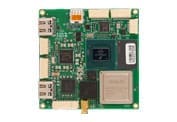In an era where data is king, AI Edge Computing is emerging as a revolutionary force, redefining data processing and artificial intelligence. A study by Gartner predicts that by 2025, 75% of enterprise-generated data will be processed at the edge, up from just 10% in 2018. In this blog, Maris Tech, leaders in low-latency, wireless, AI Edge videos, explores AI Edge Computing, its transformative impact across diverse industries, and the future of edge AI.
What is Edge AI?
Edge AI is the use of AI close to the location where data is computed, at the edge of the network. Artificial intelligence at the edge can be explained through the following parable. Imagine you’re in a busy restaurant kitchen. The chef (representing the cloud in traditional computing models) is responsible for preparing every dish ordered by the customers. However, due to the high volume of orders and the distance between the kitchen and the dining area, there’s a significant wait time for the food to reach the customers.
Now, let’s introduce AI Edge Computing into this scenario. Imagine if each table in the restaurant had its own mini-chef (representing an edge device) equipped with a set of recipes (AI algorithms). These mini-chefs can prepare certain dishes right at the table without sending the order back to the main kitchen. This setup drastically reduces the wait time for food (akin to reducing latency in data processing) and ensures that each table gets exactly what it ordered quickly and efficiently.
By bringing the food preparation (data processing) closer to the customers (end-users), the restaurant (system) becomes more efficient, responsive, and personalized. Similarly, AI at the edge brings AI algorithms directly to local devices where data is generated and used, making the whole system more efficient and responsive.
This paradigm shift offers significant advantages that will be explained further below.
Benefits of AI at the Edge
Edge intelligence has various advantages over traditional AI.
Reduced Latency: By processing data locally, Edge AI ensures swift decision-making with lower latency. Low latency is vital for applications like autonomous vehicles and real-time analytics.
Enhanced Privacy and Security: With data processed on local devices, edge artificial intelligence substantially diminishes the risk of data breaches associated with cloud storage.
Lowered Costs and Bandwidth Usage: Edge AI reduces the need for continuous data transmission to the cloud, thereby saving bandwidth and related costs.
Improved Energy Efficiency: Localized data processing means lower energy consumption, aligning with sustainability goals.

Edge AI Applications
AI Edge Computing has emerged as a game-changing technology, profoundly impacting various sectors with its innovative capabilities. Here are a few areas in which the impact of edge computing and AI is being seen
Security and Surveillance
Edge AI has revolutionized the way surveillance systems operate. By enabling real-time processing and analysis directly on surveillance cameras, Edge AI allows for immediate detection and response to security threats. This technology is particularly effective in urban areas, where Edge AI-equipped cameras are used for crowd monitoring and incident detection, enabling rapid response by law enforcement to emergencies. While specific statistics on response time improvements vary, reports indicate that implementing artificial intelligence and edge computing in surveillance systems can significantly enhance public safety outcomes.
Healthcare
Another application of Edge AI is in the field of healthcare. The Healthcare sector has witnessed transformative changes due to Edge AI. Technologies like remote diagnostics and real-time patient monitoring have become more efficient and accurate. A prime example is wearable devices that monitor vital signs such as heart rate and blood glucose levels. These devices, powered by Edge AI, provide instant feedback, enabling early detection and intervention in patient care. Research suggests that such Edge AI applications in healthcare can improve patient outcomes, though exact percentages may differ based on the application and context.
IoT
In the Industrial IoT (IIoT) sector, Edge AI has proven invaluable in enhancing efficiency and safety. For instance, Edge AI monitors assembly lines in the automotive manufacturing industry in real-time, instantly identifying defects or inefficiencies. This application of Edge AI improves the manufacturing process’s quality and significantly reduces downtime, leading to higher overall efficiency.
Autonomous Vehicles and Transportation
Edge AI plays a crucial role in reducing decision-making time in autonomous vehicles and enhancing road safety and efficiency. Autonomous trucks, for example, use Edge AI for real-time navigation and obstacle detection, which is crucial for preventing accidents. The integration of edge computing and artificial intelligence in these systems has been reported to improve response times significantly compared to traditional systems.
Smart Home
Many are wondering how to use edge AI in basic everyday activities. Smart Home technology has been transformed by Edge AI, offering more responsive and personalized experiences. Smart thermostats are a notable example, where Edge AI learns and adapts to user preferences for temperature control, leading to enhanced comfort and energy efficiency. The energy savings potential of such smart devices is substantial, with some studies indicating a reduction in energy consumption through intelligent automation.
The Emerging Role of AI in Edge Computing in Defense and Homeland Security (HLS)
Edge AI enhances operational efficiency, especially in intelligence, surveillance, and reconnaissance operations. Drones equipped with Edge AI, used for tasks like border surveillance, provide immediate analysis and threat identification. This technology has been reported to significantly increase operational efficiency and decision-making speed in military operations. Additionally, Edge AI enables real-time facial recognition and threat detection in homeland security scenarios, improving situational awareness and response times in crowded areas.
Learn more about Edge Computing for Unmanned Vehicles.
How Will Edge AI Impact the Future?
As we look into the future of AI Edge Computing, we see a world of endless possibilities and exciting advancements. The combination of 5G technology with Edge AI is set to make a significant impact, especially in areas like self-driving cars and robotics. This means faster and more reliable connections crucial for these advanced technologies. Alongside this, a wave of new, specialized hardware is being developed for Edge AI. These advancements promise better performance and enhanced security, benefiting many applications.
The field of Edge AI is continuously evolving, with new ideas and uses continuously emerging. This constant innovation keeps Edge AI at the forefront of digital transformation. In essence, AI Edge Computing is more than just a tech trend; it’s becoming a vital part of the future of technology, driving industries toward greater efficiency and innovation.
To learn more about Maris-Tech AI video streaming solutions, and how they incorporate Edge AI, contact Maris-Tech.











